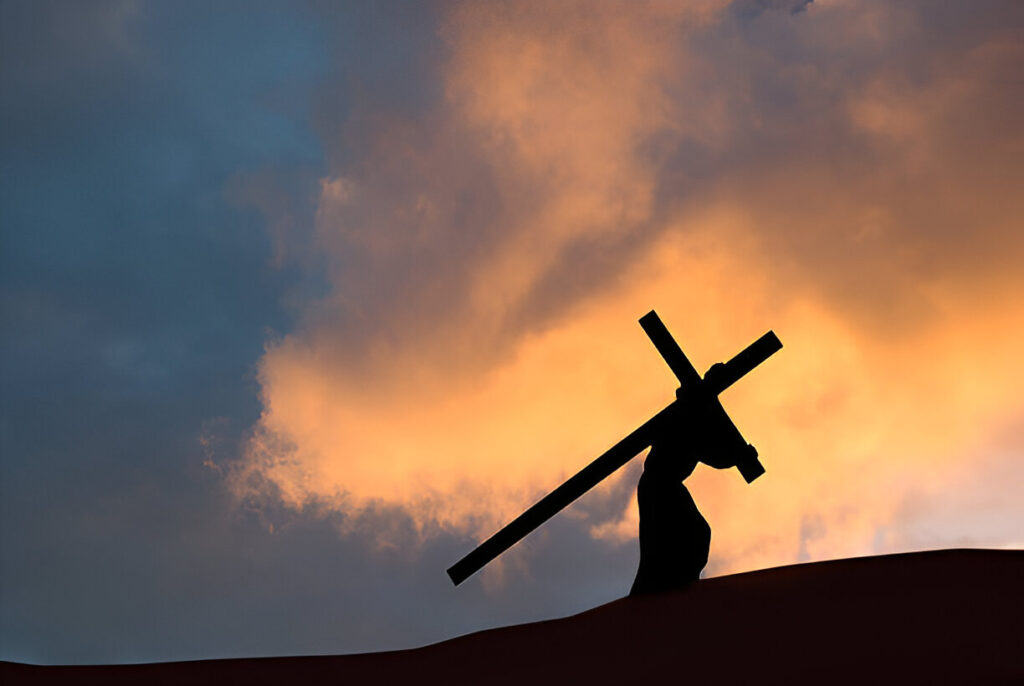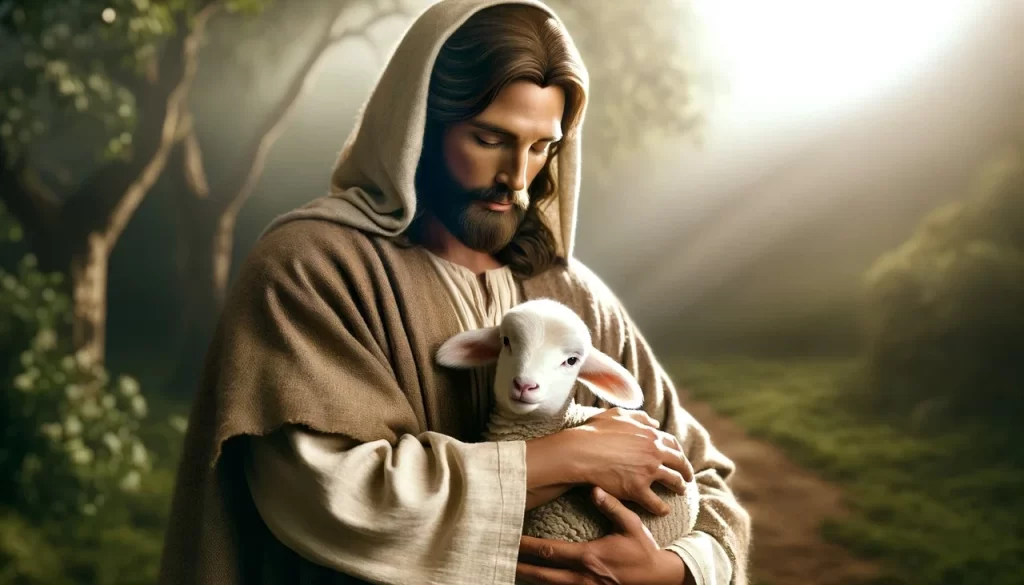To better understand the purpose of a shepherd during the times of Jesus, it is helpful to realize that sheep are utterly defenseless and totally dependent upon the shepherd. Sheep are always subject to danger and must be under the watchful eye of the shepherd as they graze. A good shepherd was committed entirely to his flock. He anticipated their needs and provided for them. Jesus is the good shepherd.
This discourse on the good shepherd is a self-sustaining unit which must have been a part of Jesus’ teaching to the Jews. This section is one of the few approaches to parabolic form of discourse that appear in John’s Gospel. It can be called an allegory since the teaching is stated in bold metaphor rather than by the characteristic simile of the Synoptic Gospels.
Dangers from Wolves and other Perils

The action of the allegory is based upon the normal daily procedure of the oriental shepherd, who in the morning enters the fold where his sheep are kept, calls to them, and leads them out to pasture for the day. In case of danger he protects them with his own life against the wolves and other perils of the wilderness, and keeps them securely until he brings them back to the fold in the evening. The imagery was familiar to Jesus’ hearers because shepherding was a common occupation in Palestine (Luke 2:8), and the Hebrew literature abounded in reference to it. The classic example of this figure is the twenty third Psalm, which pictures Jehovah’s personal care of His people.
The allegory in John 10 (1-18) was intended to present a collective rather than an individual aspect, for each time the word “sheep” is mentioned it is in the plural. Jesus was defending His “remnant” who may be equated with the “remnant” or true Israel discussed in the writing of Paul (Romans 11:1-5). The Gentiles were not excluded for they were the “other sheep” of verse 16. Though directed to Jewish ears, the teaching is catholic in its scope.
The Sheep follow the Good Shepherd

In this discourse five or six classes of people were described. The shepherd was Jesus Himself, as He declared plainly (verse 11). The “porter” or doorkeeper (verse 3), who opened the way for Him may not be identified with any particular principle or person, but simply completed the normal picture of the sheepfold. The “thieves and robbers” (verse 1) corresponded to the pseudo Messiahs of whom there had already been a large number.
The “strangers” (verse 5) may have been the same as the thieves and robbers, or any person who assumed leadership without pretending to be a Messiah. The sheep represented the Lord’s people, who hear HIs voice and follow Him (verse 27). The hireling (verse 12) should be distinguished from the thieves and robbers, since he entered the fold as an authorized agent rather than as a marauder, and since he condemned for cowardice and selfishness rather than for wanton attack of the sheep. By these metaphors Jesus evaluated the religious life and history of Israel.
The Importance of the Shepperd
The first place of importance in the interpretation should be given to the shepherd. No less than eighteen statements are made about him in the text.
- Enters through the door (verse 2)
- Receives the cooperation of the porter. (verse 3)
- Receives the obedience of the sheep. (verse 3)
- Calls his own sheep by name. (verse 3)
- Leads them out. (verse 3)
- Precedes them. (verse 4)
- Is followed by them. (verse 4)
- Is the door of the sheep. (verse 7)
- Is the only true shepherd. (verse 8)
- Is the avenue to safety and sustenance. (verse 9)
- Brings life for the sheep. (verse 10)
- Sacrifices his life for the sheep. (verse 11)
- “Knows” the sheep. (verse 14)
- Has several folds. (verse 16)
- Is under necessity of bringing other sheep. (verse 16)
- Sacrifices himself voluntarily. (verse 18)
- Possesses power over his own life. (verse 18)
- Provides security for the sheep (taken from later discourse). (verse 28)
Jesus laid down His Life for the Sheep

At least four important deductions may be drawn from these statements:
Jesus is the one key to Jewish history and the only one authorized to command the allegiance of the spiritual nucleus of Judaism. To Him the gateway of prophecy, Scripture, and history had been opened; and He had entered into HIs commission by the legitimate channel of legal descent and of spiritual appointment.
Jesus claimed that He was destined to lead His sheep out into new pastures, which implied ability to impart a deepening spiritual revelation. Pasture, according to Psalm 23, meant sustenance and refreshment of the soul of man. “He restoreth my soul” (Psalms 23:3).
Jesus interpreted His coming death as a voluntary, vicarious offering for the sheep, and He predicted that His purpose to give them abundant life would be confirmed by His own resurrection.
Jesus declared that the Jewish “sheep” were not the only ones that He had, but that the flock would be augmented by additions from other folds. The unity of the flock is determined by a common following of the one shepherd, not by the erection of a single outward organization.
The Sheep’s Dependence on the Shepherd

The second place of importance in the allegory belongs to the sheep. They are identified as follows:
- They recognize the voice of the shepherd. (verse 3)
- They follow the shepherd. (verse 4)
- They refuse to follow strangers. (verses 5, 8)
- Their safety and sustenance is in the shepherd. (verse 9)
- They are not all of one fold. (verse 16).
Recognition of the voice of the shepherd involved familiarity with it. The summons of Jesus brought response from those who finally followed Him because in Him they recognized the accents of Jehovah who had already spoken to them in the revelation of the Old Testament. As Peter states in 6:68, “Thou hast the words of eternal life.” The inherent quality of Jesus’ teachings identified Him as the true Shepherd of souls. This concept is supported by the Shepherd’s own claim stated in verse 30, “I and the Father are one.”
The symbolism of verse 9 deserves special comment. The oriental shepherd usually stood in the doorway of the sheepfold as the sheepfold as the sheep went in or out, and passed them one by one as he counted and inspected them. He was their door to safety, to freedom, and to satisfaction of their wants. The life of the sheep was dependent upon the power and provision of the shepherd. Their recognition of him and his recognition of them established the relationship. Hearing his voice, following his leading entering the fold through him, and the refusal to follow others was John’s picture of belief.
The Characteristics of the Hireling

The Hireling has four characteristics:
- He lacks the spontaneous responsibility of the shepherd for the sheep. (verse 12)
- He is cowardly, and flees in the face of danger. (verse 12)
- He has no particular concern for the sheep. (verse 13)
- His sole interest is in the recompense. (verse 13)
Although no explicit comparison is stated, Jesus probably was representing the priestly party by the hirelings. The later actions of the priests and Pharisees made the metaphor apt. In the council which was held after the raising of Lazarus, they expressed their fear of Jesus’ success. “If we let him thus alone, all men will believe on him: and the Romans will come and take away both our place and our nation” (John 11:48). They were more concerned with their place and their nation than with Jesus, who was the very reason for their national existence. Furthermore, the order of their words showed that their position meant more to them than their national life, and that they valued profit above the spiritual welfare of their charges.
The teaching of Jesus during this period was a parallel development of belief and unbelief among the hearers of Jesus, and the result and clash of these two opposing forces. The bewilderment of some, the outspoken opposition of others, and the slow but steady development of a triumphant faith on the part of Jesus’ disciples are all recorded.

